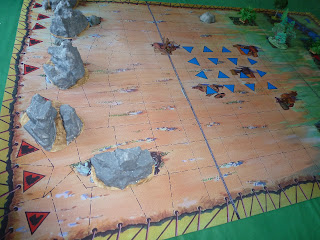Following on from the previous post, here are closeups of the second new shelf. The shelves are inside a pine wardrobe built into a chimney alcove, long since unfit for purpose but I'm averse to ripping out period features so it now houses toy soldiers and the original doors provide some protection from the dust.
When I have a little money, I buy Toy Soldiers; and if I have any left, I buy food and clothes. (with apologies to:) ERASMUS
Wednesday, 14 May 2025
Assorted Ancients now on display.
Friday, 14 January 2022
Battle of Metauro revisited
In the closing weeks of last year Anthony and I decided to take his 54mm Battle of Metauro game for another spin, originally this was a board game made in Spain by Rojas y Malaret, Anthony took the original board and had it blown up as a gaming mat for 54mm toy soldiers, here's how the game works: (click on the images to enlarge them)
Tuesday, 17 August 2021
Batalla del Metauro
From the same stable as the Battle of the Little Big Horn game that Anthony and I played back in June comes this Punic Wars game based on the Battle of Metaurus. Originally designed and published in Spain by Rojas y Malaret, as part of a series of games called "Great Battles of the World" then subsequently produced under licence in Germany by O.M.Hausser.
Saturday, 26 June 2021
Battle of the Little Big Horn
Anyone who was a schoolboy in the 1960's will remember the Waddingtons board game of the Battle of the Little Big Horn, it came with some rather nice 40mm figures of General Custer, his 7th Cavalry and the opposing Sioux and Cheyenne Indians. Well sometime last year Anthony had the original board copied onto a 6'x4' mat for use with 54mm toy soldiers but the ensuing pandemic has prevented us playing it, until today, which by the purest of coincidence happens to be the 145th anniversary of the actual battle.





























